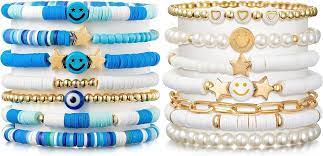Caring for and cleaning your bracelets is essential to maintain their appearance, longevity, and overall condition. Bracelets, often exposed to elements such as skin oils, lotions, and environmental factors, can accumulate dirt and lose their luster over time. Whether your bracelets are made of precious metals, gemstones, leather, or other materials, here’s a comprehensive guide on how to care for and clean them to keep them looking their best:
**1. **Avoid Harsh Chemicals:**
One of the fundamental aspects of bracelet care is avoiding exposure to harsh chemicals. Remove your bracelets before engaging in activities that involve contact with chemicals, such as cleaning, applying perfumes, or swimming in chlorinated pools. Chemicals can tarnish metals, damage gemstones, and affect the overall appearance of the bracelet.
**2. **Store Properly:**
Proper storage is crucial to prevent tangling, scratching, or damage to your bracelets. Consider storing them in a designated jewelry box with individual compartments or pouches. Keep bracelets away from direct sunlight and extreme temperatures, as these conditions can affect certain materials over time.
**3. **Regular Cleaning Routine:**
Establishing a regular cleaning routine will help prevent the buildup of dirt and oils on your bracelets. The frequency of cleaning depends on how often you wear the bracelets and the materials they are made of.
– **Metal Bracelets:** For bracelets made of metals like gold, silver, or stainless steel, a gentle cleaning solution can be made by mixing warm water with a few drops of mild dish soap. Use a soft brush, such as an old toothbrush, to scrub the bracelet, paying attention to any intricate details. Rinse thoroughly with clean water and pat dry with a soft cloth.
– **Gemstone Bracelets:** Gemstones require careful cleaning to avoid damage. Use a soft, lint-free cloth to wipe away surface dirt. For a deeper clean, you can use a mild soapy solution and a soft brush. Be sure to check if the gemstone has any specific cleaning requirements, as certain stones may be sensitive to chemicals or excessive moisture.
– **Leather Bracelets:** Leather is a porous material that can be damaged by water. To clean leather bracelets, use a dry, soft cloth to wipe away surface dirt. Avoid exposing them to water or liquids, as this can cause the leather to weaken or lose its color. If your leather bracelet gets wet, pat it dry with a soft cloth and allow it to air-dry naturally.
**4. **Professional Cleaning:**
Periodically, consider having your bracelets professionally cleaned by a jeweler. Jewelers have specialized tools and equipment to clean and polish bracelets without causing damage. Professional cleaning is especially recommended for intricate designs, bracelets with delicate features, or those that require specific care.
**5. **Inspect for Damage:**
Regularly inspect your bracelets for signs of wear and tear. Check for loose stones, worn clasps, or any damage that may need prompt attention. If you notice any issues, consult with a jeweler for repairs to prevent further damage.
**6. **Avoid Excessive Wear:**
While bracelets are meant to be worn, excessive wear can lead to strain on the materials and potential damage. Avoid wearing bracelets during activities that may subject them to unnecessary stress, such as sports, heavy lifting, or rigorous physical activities.
**7. **Consider Material-Specific Care:**
Different materials require specific care. For example:
– **Pearl Bracelets:** Pearls are delicate and should be handled with care. Avoid exposing them to chemicals, and wipe them with a soft, damp cloth after each wear.
– **Bracelets with Fabric or Beads:** Fabric or beaded bracelets may require more delicate cleaning methods. Check for any care instructions provided by the maker or consult with a jeweler for guidance.
**8. **Restringing and Maintenance:**
If your bracelet has strands that are strung together, such as bead or pearl bracelets, consider having them restrung periodically. This preventive measure helps ensure the integrity of the bracelet and prevents breakage.
By incorporating these care and cleaning practices into your routine, you can keep your bracelets looking beautiful and in optimal condition. Remember that each bracelet may have specific care requirements based on its materials and design, so always refer to any care instructions provided by the manufacturer or consult with a jeweler for personalized advice. With proper care, your bracelets will continue to be cherished accessories that enhance your style for years to come.




